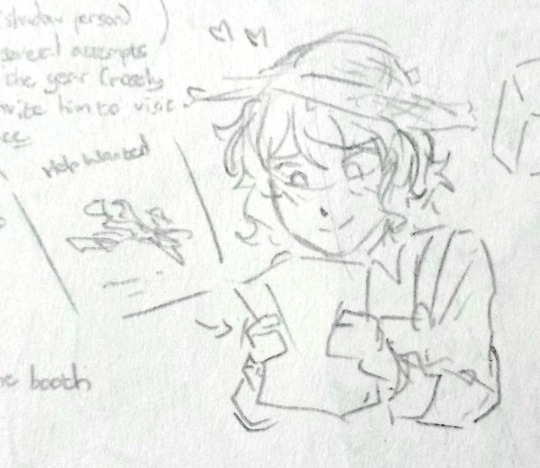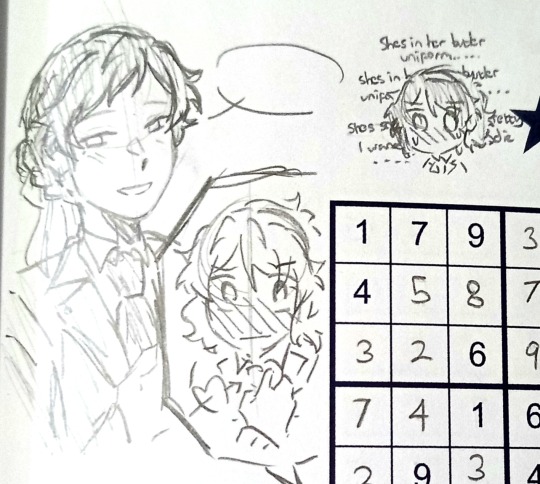#more like sudoku book stuff but. technicalities you have no idea how many times i doodled them in the margins
Text




i wasnt rly gonna post these outside of my sideblog but im feeling kind of miserable today therefore. be free

#sketchbook stuff#more like sudoku book stuff but. technicalities you have no idea how many times i doodled them in the margins#theyre both trans here bc yes#im not putting yhese in the tags. woe
58 notes
·
View notes
Text
PROJECT BATTLE SHELL: AN EXPLANATION
OKAY SO! Here is my more in-depth thoughts on the project. These are my earliest thoughts and ideas for it, and I'll explain more about them in future posts.
First off. Why am I not just buying a back protector? Answer: That’s boring, why would I do that if I could do this instead? Yes, I fully acknowledge that it would be easier to buy a back protector and simply modify it.
Second, what makes me qualified to take on this project? Answer: What makes me unqualified? I’ve taught myself enough semi-related skills and can teach myself further skills SO. PLUS I have the power of hyperfixation on my side and enjoy making stuff, so that’s probably all the qualifications I need. ...probably, we'll see!
Below is all the more technical speak, thanks for the interest!
NOW lets get into the nitty gritty.
I have a few plans for how to approach this project, so the skills I’ll be using and materials I’ll require will be impacted by which approach I choose. Although I have many ideas for separate little bits of how the project will come together, I have two main ideas on how to approach the base structure. Plus ideas for add-ons, fun features, etc, but that all comes later and relies on the base structure.
What I'll be referring to as the Base Structure is the structure that will hold the battle shell together. Think of it as the core, the body, or the skeleton of the shell. Everything else will be planned and built around this "skeleton", so it's important to choose a base structure that can support the rest of the build.
Structurally, regardless of which base structure I chose I have a few main features for the battle armour.
First is that I’m planning to have a mesh layer that will help hold everything together. Instead of relying solely on a solid frame to hold the battle shell together, I’ll have a mesh that has key connection points that attaches directly to the battle shell. This, hopefully, will additional support and flexibility to the shell.
Second is how to wear it. I am creating this battle shell to be as discreet as possible. I want to be able to wear it under a sweater or a jacket without anyone really noticing. Below you can see my rough sketches on how it will connect to the user’s body and be held in place while also flexing with the user’s movements.

(apologies for my messy writing. All of it is similar to what I'll be talking to here. My note style is rather disorganized, as most of my thoughts and ideas are still within my brain and not yet on paper.)
With the main connections points being around the shoulders, chest, and lower back/waist I believe I’ll be able to have the shell connect close enough to the user’s body that it won’t stick out in awkward ways while wearing it. Though adjustments will be made once this can actually be tested. Best seen in the lowest left sketch, although future sketches will elaborate on the system.
ONTO THE BASE STRUCTURE OPTIONS
I have two main ideas for the base structure. These are based on two different construction points. Both focus on finding a balance between flexibility vs durability, something future me will likely have to consider further when it comes to finding materials. The structure needs to have enough strength that it can protect and absorb force, but cannot be too stiff as that can make it more fragile when bending forces are applied, and more obvious when wearing.
The first base structure I'm considering is a plate system. Akin to a fusion between a turtle shell and scales, the plate system will be dependent on connection points between the plates. The plates will be in different sizes depending on where on the back it is situated, and would need solid attachment to the material mesh for flexibility.

(here's the most recent sketch based on calculations I've been making for conceptualizing the plating system. Please ignore the ancient sudoku book, I am definitely not a time traveller).
Downside of this approach is the complexity. Each piece will have to sit perfectly in position, which means each piece will have to be 100% custom made and perfectly mirrored. There's also issues with the plates wearing against each other, the overlap points being particularly uncomfortable, and the plates jutting out.
Upsides of this approach is the customizability and testability. The most important point will be making the connection points between the shells, however once those are created making new plates, adjusting pre-existing plates, and more will be far easier. Additionally it'll be easier to test the plating system because I'll be able to adjust it and create new plates based on data collected.
I'll have another post explaining the plate system more later. That post will go into my ideas for material choices, which will be interesting <- lots of experiment and research.
The second base structure Idea I have is created a shaped (but still flexible) one piece structure. It would be formed out of small hexagons (similar to a beehive construct). Most similar to commercial back pieces, I believe that the beehive structure would allow for a durable material that can also take some flex and bend.
Downside of this approach is actually creating it. In a perfect world I'd have a 3D printer or a full on lap and materials that I could make a mathematically perfect mould for this, however that's not the case. Any changes in angles between the hexagonal pieces will take re-creating those pieces and possibly any they connect to, as well as many edge pieces. There's also the size factor for the individual hexagons, and how that would impact the actual strength of the project.
Upside of this approach is how solid it would be. Because it wouldn't rely on connection points (the entire piece would be connected to itself, so to speak) it would lose many of the weak spots that the plate system has. It also wouldn't have the overlap issue.
I'll make another post covering my thought process on the materials to use for this project, and soon I'll post an update on my physical progress. Thank you for reading.
#Subject: Project Battle Shell#Subject: PBS Thoughts#rottmnt#introduction#technically still an intro to the project.#There is still much to cover and research!
1 note
·
View note